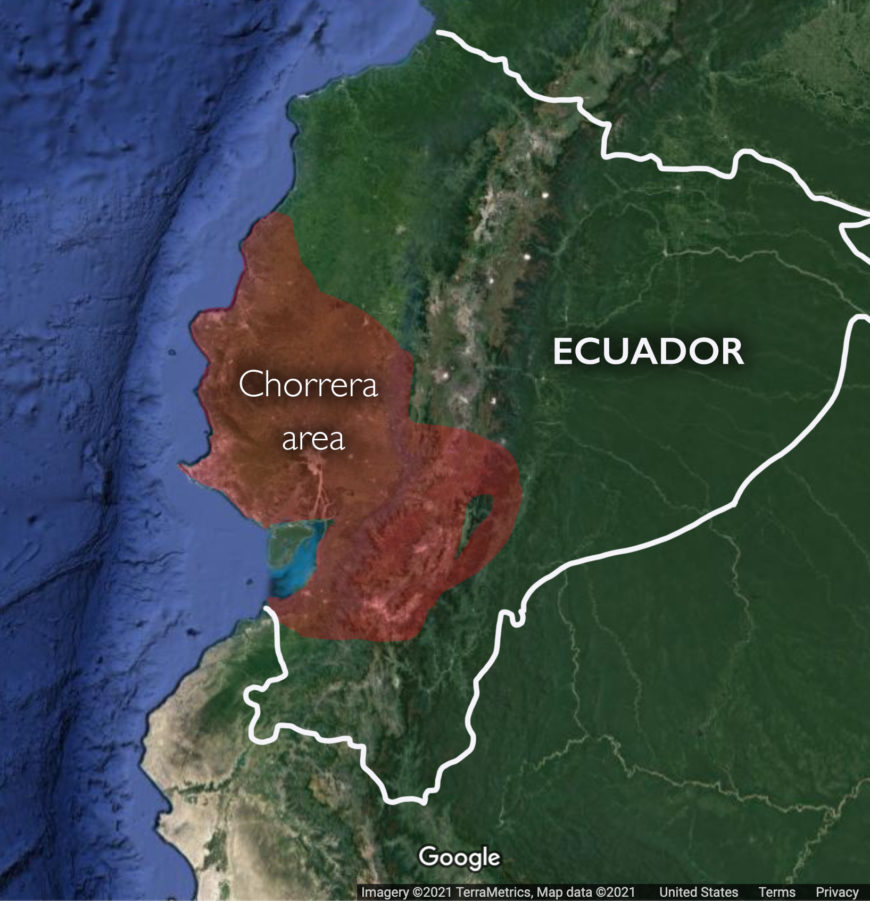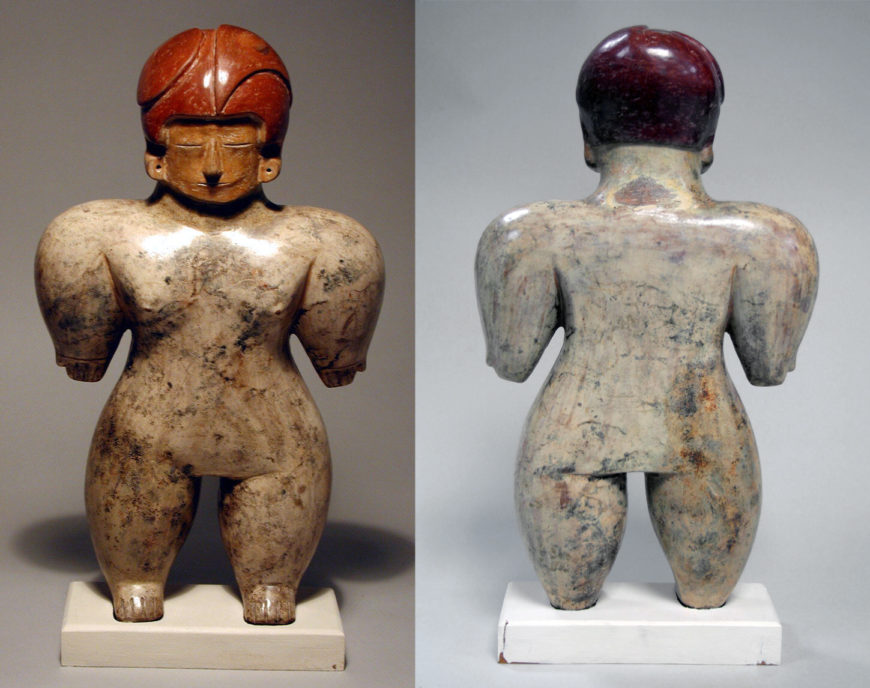
Standing Female Figure, Chorrera culture, Ecuador, 10th–2nd century B.C.E., ceramic and slip, 14 inches high (The Metropolitan Museum of Art)
“Brought to an end by a volcano” is not a sentence we often see. Yet the Chorrera, who once held influence over a wide portion of what is now Ecuador, met exactly that fate. Now, looters looking for antiquities to sell on the black market are another hazard that they must endure.
The modern country of Ecuador is a land of geological contrasts, from the lofty volcanic peaks of the Andes mountains in the east, to tropical forests leading down to the western coast. Over its long history, many different cultures have come and gone, each with its own artistic style. In the ancient past, a group of people called the Chorrera occupied a large part of western Ecuador, and their artistic style would have a strong influence over the cultures that would follow, especially their representations of human figures.
Yet the Chorrera, a group of cultures united by in part by a common artistic style who once held influence, flourished in the verdant western coastal lowlands, extending from Esmeraldas south to the Guayas Basin, and their influence reached into the Andean highlands, probably via trading routes that exchanged coastal products like Spondylus shell for highland obsidian. From about 1300–300 B.C.E., they dominated the coast. Their dominance, at least in some areas, may have come to an end due to the major eruption of the Pululahua volcano in 467 B.C.E. Many of the Chorrera ceramics featured in museums probably date from c. 900–500 B.C.E., a time frame associated with particularly fine ceramic production. However, extensive looting of many Chorrera ceramics means that these pieces do not have the contextual information needed to securely date them.
Crafting culture in clay
Chorrera ceramic artists were specialists who developed a sophisticated ceramic technology that allowed them to create elaborate vessels and highly expressive sculptural works, and they would have an influence on the later Jama-Coaque culture in the same region, who are known for their elaborately costumed figural sculptures. While it is difficult to know precisely what these ceramics meant, they were probably used for ritual purposes, whether to represent supernatural forces or to accompany the dead. Without written records (the Chorrera did not use a writing system), and with the loss of context that comes from looting, it is difficult to develop more specific ideas about the use and cultural significance of sculptures like these.
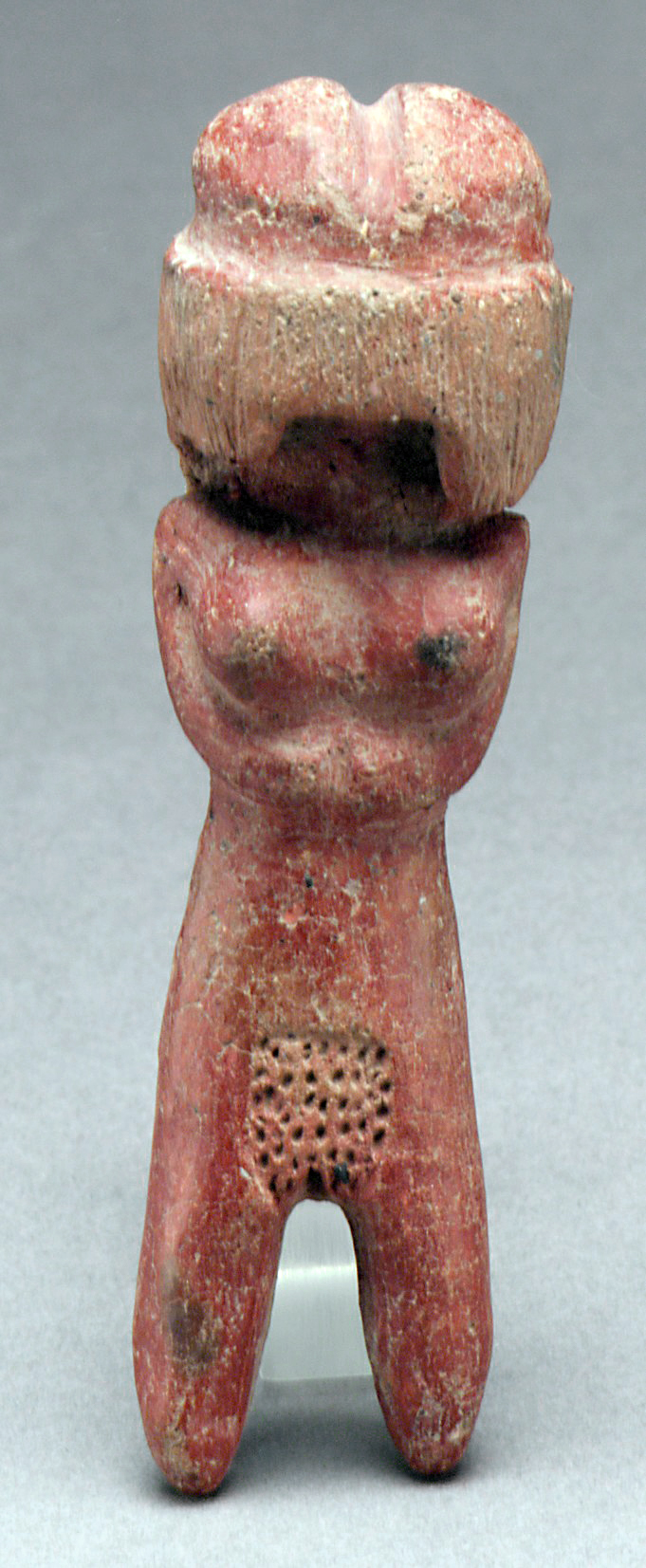
Female figure, Valdivia culture, late 3rd millennium B.C.E., ceramic, Ecuador, 9.2. x 2.5 x 2.5 cm (The Metropolitan Museum of Art)
Unlike earlier ceramic representations of human figures from the area (such as a female figure from the Valdivia culture), which were small and solid, Chorrera figures are hollow, either as self-contained sculptures or as vessels, and can be rather large (the Chorrera standing female figure is 14 inches tall). The sculptural figurines were made using molds to create the more detailed front of the figure, while the less-detailed backs were hand-finished. The molds appear to have been held as important objects in their own right, as at least two repaired molds (most likely from funerary contexts, as that is the source of most looted material) are known, implying that they were treasured objects.
Both women and men are depicted, which was also a change from earlier cultures, which mostly depicted female figures (scholars speculate that this is because the figurines were associated with fertility, but there is no conclusive evidence of this). The standing female figure at The Metropolitan Museum of Art is typical of these kinds of Chorrera sculptures, standing in an upright, frontal, and static pose, with the arms down at the sides. Rather than indicating elbows, her arms are shown as a single, tapering form, ending in tiny hands. Her hands are turned so that the palms face us, and her body is meticulously symmetrical, with the exception of her abstracted hair formed into swirling shapes. However, the sculpture still has a fluid, organic quality that comes from an almost pillow-like treatment of the figure, emphasizing the curves of her body. The highly polished slip paint adds to the sleekness of her form.
Her face is highly simplified, with the eyes and mouth shown closed and depicted by simple lines. Her nose is a streamlined, geometric shape, and her earlobes have basic depictions of earspool ornaments in them. She is otherwise naked and unadorned, although it is possible that she was originally meant to be dressed and bedecked with other materials.
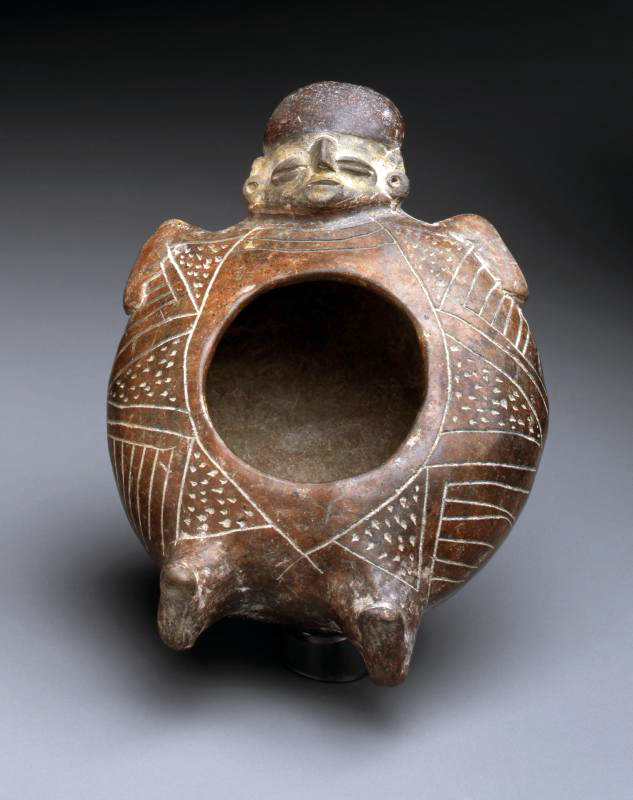
Human Effigy Vessel, Chorrera culture, Ecuador, 1200–300 B.C.E. ceramic and slip, 10.8 x 19 x 13.3 cm (Michael C. Carlos Museum, Atlanta, GA)
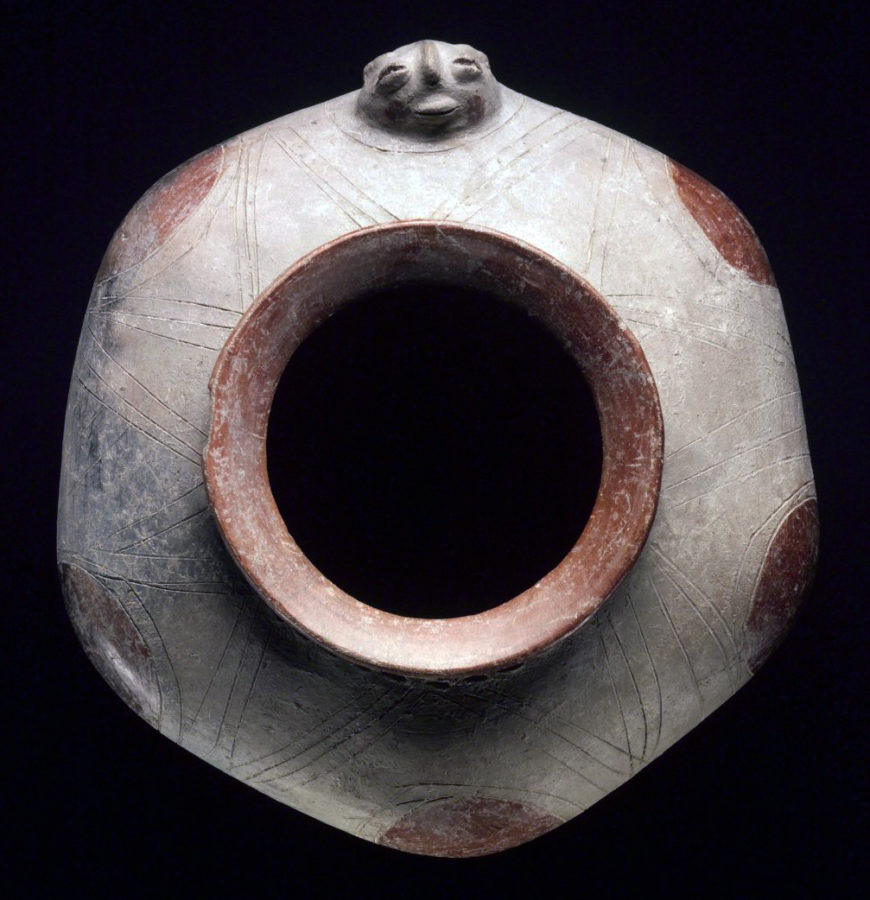
Bowl, Chorrera culture, Ecuador, 1200-300 BCE ceramic and slip, 16.5 cm diameter (Brooklyn Museum)
In contrast, the genderless figure shown in another vessel (from the Michael C. Carlos Museum) has incised lines and textures surrounding the vessel opening, which may depict a textile pattern or body paint. The mouth and eyes are more sculptural than in the figure above, although still closed: they project from the surface of the face in simplified forms. We can see that the earlobes also have earspool ornaments, like the figure at the beginning of the essay. What may be hair has been depicted here as a smooth, almost helmet-like form (and so perhaps may be a hat), without the designs seen on the standing figure.
Possibly to accommodate the function of the vessel, the limbs are small and compact; this figure does not have the swelling forms of the sculpture of the standing woman. The opening of the vessel is a simple circle located where the belly of the figure would be. A bowl in the Brooklyn Museum is an abstracted version of the same idea, with only the human head recognizable. Some versions of this vessel type have a flared lip for the opening, as in the Brooklyn example, while others, like the one in the Michael C. Carlos Museum, have a plain opening. It would seem that these forms equate the vessel with the body and vice versa, but until more scientifically-excavated examples are studied, it is not possible to know for sure.
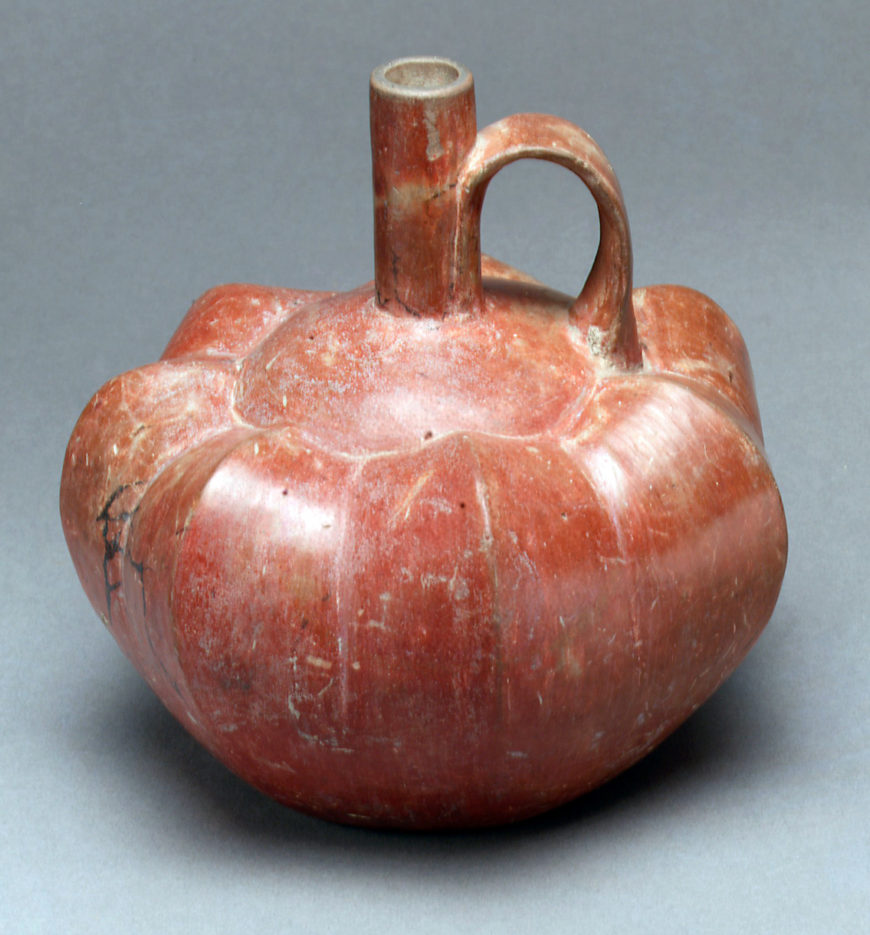
Spouted Bottle, Chorrera culture, Ecuador, 12th–4th century B.C.E., ceramic, 15.2 × 15.2 cm (The Metropolitan Museum of Art)
Making the world around us
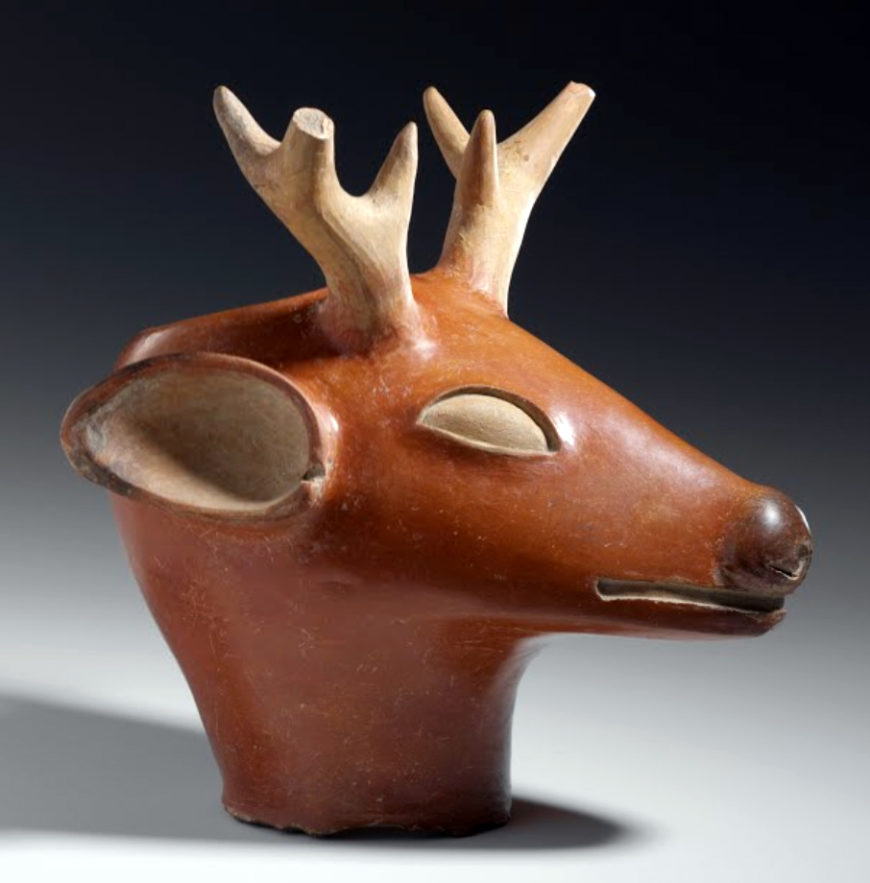
Zoomorphic vessel, Chorrera culture, 950–350 B.C.E., north coast of Ecuador, 25.5 x 24.2 cm (Museo Casa del Alabado, Quito)
While humans are a common theme in Chorrera ceramics, they were not the exclusive subject matter. Animals and plants were also represented, and the sleek, idealized depiction of a squash in another vessel is typical of these artworks. The ridges of the form make the squash visible without adding extra details, presenting the viewer with a minimal, perfected plant form. The clay of this vessel would have been polished while semi-dry (a state referred to as “leather hard”) with a smooth stone, resulting in the shiny surface finish seen on the squash and the standing female figure. Like the human figures, these may have had a spiritual purpose, used in rituals meant to ensure future harvests.
The eruption of the Pululahua volcano of 467 B.C.E., and the blanket of ash it laid over a significant portion of Ecuador, appears to have brought about the end of the Chorrera cultural system. It may have seemed to many that the world was ending as the ground shook and the sky turned black; the effect the ash would have had on agriculture would have lasted for years, if not decades. When the world did return to normal, new cultures arose, but many still remembered the Chorrera past and were influenced by their art—perhaps through heirloom ceramic molds, carefully kept ceramic pieces, or cultural memory of the time before the world ended.
Additional resources:
Tom Cummins, “Tradition in Ecuadorian Pre-Hispanic Art: The Ceramics of Chorrera and Jama-Coaque,” in Amerindian Signs: 5,000 Years of Precolumbian Art in Ecuador, edited by Francisco Valdez and Diego Veintimilla (Quito: Ediciones Colibrí, 1992), 63–81.

